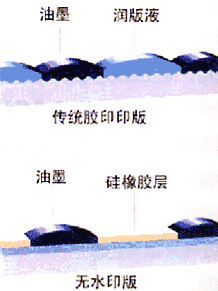Waterless printing is also a lithographic offset technology, except that it does not use the fountain solution necessary for conventional lithographic offset printing. It uses a special silicone rubber coated plate, special inks, and a strict temperature control system on the press.
In waterless printing, the printing process has changed from a chemical process using isopropyl alcohol or other fountain solution to a simple mechanical process. The print operator also does not have to adjust the ink-water balance. All waterless printing systems require a temperature range—the ink is transferred to the plate.
There are currently three manufacturers producing waterless printing plates. Toray Co., Ltd. of Japan produces two types of plates: one is a photosensitive and waterless version that requires film exposure and printing, and the other is a recently introduced computer-to-plate product.
The waterless version of PearlDry developed by the United States Presstek Corporation does not require exposure or printing. PearDry waterless plate is mainly used in machine imaging plate making, used for DI printing presses, such as Heidelberger's QM-DI, Adast's Omni AdastDI and newly launched Karat 74DI. These printers occupy most of the color short live-demand printing market.
Kodak also recently introduced a waterless version that is in the testing phase.
The number of screens provided by these presses ranges from 150 lines/inch to 200 lines/inch.
Presstek's PearlDry waterless version is aluminum-based and is directly imaged on a direct platemaking machine. The maximum size of these plates is 102 cm, and the maximum number of screens is 240 lines/inch. The new product PearIDry Pus without watermark version can reach 300 lines/inch.
Waterless printing can quickly turn over the printing, reducing print preparation time and paper waste. It also eliminates the chemical contamination of fountain solution in traditional printing.
The waterless version can achieve a high number of screens and deliver more ink to the print. In color printing, a larger color range can be generated. The unwatermarked version is a flat intaglio with the graphic part below the surface of the printing plate. Since there is no wetted part, there is no emulsification problem with the ink. Therefore, you can print clear, bright images.
Second, the principle of waterless printing 1. Toray system (1) Toray waterless version of Troray waterless printing system is mainly composed of three parts: no watermark version, waterless ink and temperature control system on the machine.

The Toray waterless version can be exposed using a conventional PS version of the printing device and light source. The exposure time is also not much different from the traditional PS version. At the time of exposure, the UV light, which is controlled by the film, penetrates the silicone rubber layer and reaches the photosensitive resin layer. The photosensitive resin in the graphic part absorbs UV light and reacts and falls off at the junction of the photosensitive resin and the silicone rubber layer. This kind of photoreaction is very fine, and the printing plate is also easy to get high resolution. When the number of screen lines is 175 lines/inch, it can reproduce 0.5% to 99.5% of the dots.
After the Toray waterless version is exposed, it needs to be processed. The processing equipment is unique to the system and uses special chemical and mechanical methods to process the plates.
The non-image area on the treated waterless plate is an ink-repellent silicone rubber layer; on the area of ​​the image, the silicone rubber layer is removed leaving the ink-receptive photosensitive resin layer. Also, the printing plate design can ensure that the printing plate does not use fountain solutions such as water and alcohol, and can selectively absorb ink or ink. (To be continued)
Jacquard elastic tapes jacquard elastic webbings are commonly used in a variety of different close-fitting products, including suspenders, underwear,
bathing suits, hair scrunchies and bras.Jacquard Elastic Tape may also be used to make watch bands and similar accessories.
Are you looking for a wide range of Jacquard Elastic Tape? Then you`ve come to the right place. Our team offers swift advice and efficient procedures. We will of course take into account your particular wishes, including aspects such as presentation, packaging and logistics.
Jacquard Elastic Tape
Jacquard Elastic Tape,Jacquard Elastic Band,Jacquard Elastic Suspender Tape,Jacquard Elastic Nylon Tape
Shenzhen Hong Le Xing Textile Co.,Ltd , http://www.hlxelastictape.com